Elevated serum uric acid and triglycerides level in the patients with Type II Diabetes Mellitus- a Nepalese case control study
DOI:
https://doi.org/10.3126/acclm.v2i2.15590Keywords:
Hyperuricemia, Hypertriglyceridemia, Type II Diabetes MellitusAbstract
Background: Hyperuricemia is associated with type 2 diabetes, which is a metabolic disorder of multiple etiologies resulting from defects in insulin action. The present study wascarried out to look for any association between uric acid and Type II Diabetes Mellitus and also status of triacylglycerol level among those patients.
Methods: The blood samples were collected 100 diabetic and 100 non-diabetic individuals in the department of biochemistry and then analyzed for estimation of blood glucose, Uric Acid and Triacylglycerol level.
Results: The average level of serum uric acid in diabetic patients was higher (5.706±1.617) in comparison to non diabetic subjects (4.322±0.784) with statistically significant difference (p≤0.05). For female the result indicate there was a positive correlation between (FBS and triglycerides) and (triglycerides and uric acids) which was statistically significant (r =-0.465, n = 41, p = 0.002) and(r =-0.370, n = 41, p = 0.017) respectively.
Conclusions: This study documents that hyperuricemia is associated with type 2 diabetes mellitus. Furthermore, the serum triacylglycerol and serum uric acid is also found to be associated risk factors for diabetic complications. Hence, timely diagnosis and management of diabetes is vital to control the complications related to diabetes.
Ann. Clin. Chem. Lab. Med. 2016:2(1); 26-34
Downloads
Downloads
Published
How to Cite
Issue
Section
License
Authors who publish with this journal agree to the following terms:
- The author transfers copyright to the Nepalese Association for Clinical Chemistry.
- The journal publishes the work under a Creative Commons Attribution License that allows others to share the work with an acknowledgement of the work's authorship and initial publication in this journal and under the same share-alike license used here.
- Authors are able to enter into separate, additional contractual arrangements for the non-exclusive distribution of the journal's published version of the work (e.g., post it to an institutional repository or publish it in a book), with an acknowledgement of its initial publication in this journal.
- Authors are permitted and encouraged to post their work online (e.g., in institutional repositories or on their website) prior to and during the submission process, as it can lead to productive exchanges, as well as earlier and greater citation of published work (See The Effect of Open Access).




